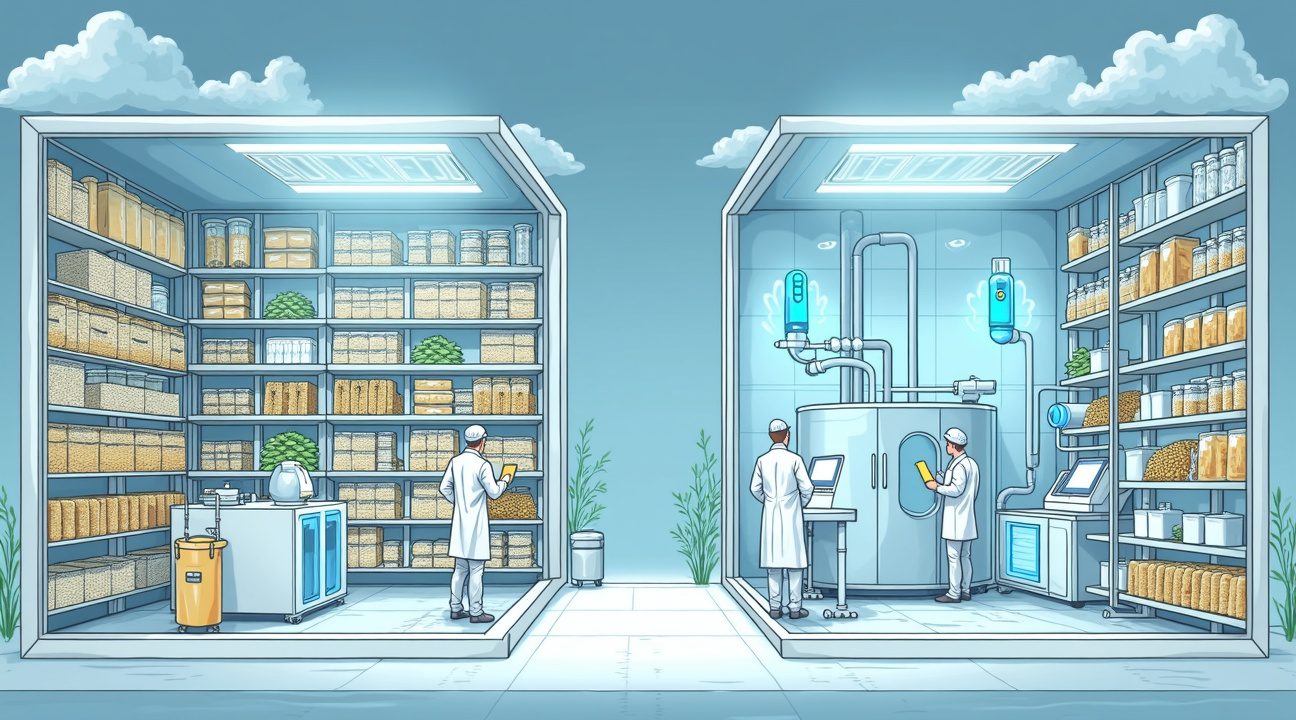Agricultural modernization has eliminated more than 75% of plant genetic diversity, prompting scientists to develop comprehensive preservation strategies through global gene banking networks, advanced cryopreservation techniques, and integrated conservation approaches.
These efforts combine traditional seed storage, cutting-edge molecular preservation, and natural habitat protection to create a genetic safety net for humanity’s agricultural future.
Key Takeaways
- Global gene banks preserve millions of crop varieties through over 700 facilities worldwide that store seeds, tissues, and genetic material under controlled conditions to prevent further genetic loss
- Cryopreservation at -196°C using liquid nitrogen provides indefinite storage for genetic materials, while standard seed banking at -18°C to -20°C maintains viability for decades at lower costs
- In situ conservation protects species in natural habitats where they continue evolving and adapting, preserving ecological relationships and ongoing genetic adaptation that cannot be replicated artificially
- DNA banking and molecular storage complement traditional methods by preserving genetic blueprints at the molecular level, with facilities like the Royal Botanic Garden maintaining over 20,000 DNA samples
- Integrated conservation strategies combining multiple approaches create redundant safety systems that address individual method limitations while maximizing genetic preservation success across different species and environmental challenges
The Growing Threat to Crop Diversity
Modern agriculture faces an unprecedented genetic crisis. Industrial farming practices have dramatically reduced crop diversity, leaving humanity vulnerable to diseases, climate change, and food security threats. Scientists respond with sophisticated preservation networks that safeguard genetic resources through multiple interconnected approaches.
Global Gene Banks
Global gene banks form the backbone of conservation efforts. These specialized facilities operate sophisticated storage systems that maintain optimal conditions for genetic material preservation. Temperature controls, humidity regulation, and contamination prevention ensure materials remain viable for extended periods. Each facility contributes to a worldwide network sharing resources and expertise.
Advanced Cryopreservation Techniques
Cryopreservation represents the most advanced preservation technology available today. Liquid nitrogen storage at -196°C essentially stops biological processes, creating indefinite preservation potential for seeds, tissues, and genetic samples. This technology proves particularly valuable for materials that cannot survive traditional storage methods. Standard freezing at -18°C to -20°C offers cost-effective alternatives for many species while maintaining viability for decades.
In Situ Conservation and Natural Habitats
Natural habitat conservation provides irreplaceable benefits that artificial storage cannot replicate. Species continue evolving in response to environmental pressures, developing new resistance traits and adaptations. These dynamic processes maintain genetic diversity at levels impossible to achieve through static storage systems. Protected areas and agricultural reserves serve as living laboratories where crops and wild relatives interact naturally.
Molecular Storage and DNA Banks
DNA banking opens new frontiers in genetic preservation. Molecular storage captures genetic blueprints at their most fundamental level, preserving information even when organisms cannot survive traditional methods. Specialized facilities maintain vast collections of genetic samples, with some institutions housing tens of thousands of DNA specimens. These molecular libraries support research, breeding programs, and future biotechnology applications.
Integrated Conservation Strategies
Conservation success requires integrated strategies that combine multiple preservation methods. Single approaches carry inherent risks and limitations that comprehensive programs address through redundancy and specialization. Seed banks excel at preserving orthodox seeds, while tissue culture maintains species requiring different conditions. Field gene banks protect materials requiring live preservation, and molecular storage captures genetic information for future applications.
Global Collaboration and Knowledge Sharing
International cooperation drives conservation effectiveness through shared protocols, resource exchange, and collaborative research initiatives. Regional networks address specific environmental challenges and crop varieties while contributing to global preservation goals. Technology transfer and capacity building ensure developing nations can participate effectively in conservation efforts.
Impact of Climate Change
Climate change adds urgency to genetic preservation efforts. Rising temperatures, altered precipitation patterns, and extreme weather events threaten both natural habitats and storage facilities. Conservation programs adapt through climate-controlled storage upgrades, geographic distribution of materials, and enhanced monitoring systems that protect against environmental threats.
Economic and Technological Factors
Economic considerations influence conservation strategy development and implementation. Cost-effective storage methods enable broader participation while advanced technologies serve specialized preservation needs. Public-private partnerships provide funding and technical expertise that individual institutions cannot achieve independently. Investment in conservation infrastructure pays dividends through improved food security and agricultural resilience.
The Role of Research and Innovation
Research applications drive innovation in preservation techniques and storage technologies. Scientists develop new methods for difficult-to-preserve species while improving existing protocols for better efficiency and longevity. Genetic analysis informs collection priorities and guides preservation decisions based on diversity assessments and conservation value.
The Future of Genetic Preservation
Future developments promise enhanced preservation capabilities through emerging technologies. Synthetic biology may enable genetic reconstruction from molecular information, while improved cryopreservation techniques could expand preservation options for currently difficult species. Automated storage systems will increase capacity and reduce operational costs, making conservation more accessible globally.
A Genetic Safety Net for the Future
Agricultural genetic preservation stands as humanity’s insurance policy against an uncertain future. Multiple preservation approaches create resilient systems that protect genetic diversity through various threats and challenges. These efforts ensure future generations inherit the genetic resources necessary for food security, agricultural adaptation, and continued crop improvement in an evolving world.
The World Is Losing 75% of Plant Genetic Diversity – Here’s How Scientists Are Fighting Back
Agricultural modernization has created an unprecedented crisis in plant genetic diversity. More than 75% of plant genetic diversity and 90% of traditional crop varieties have vanished from farmer fields as industrial farming practices favor high-yielding monocultures over diverse traditional varieties. This dramatic shift toward uniformity has stripped agriculture of the genetic foundation it needs to adapt and survive.
The consequences extend far beyond statistics. Food security hangs in the balance as crops become increasingly vulnerable to new diseases, changing climate patterns, and environmental stresses. Traditional varieties that once thrived in specific local conditions – resistant to drought, pests, or extreme temperatures – have been replaced by genetically uniform crops that may fail when conditions change. The loss also eliminates potential sources for developing new resilient varieties that could feed future populations.
Global Gene Banking Networks Preserve Genetic Heritage
Scientists have mobilized a comprehensive response through an international network of gene banks. Over 700 facilities worldwide now store millions of crop accessions and wild species, creating a genetic insurance policy for humanity’s agricultural future. These repositories collect, catalog, and preserve seeds, plant tissues, and genetic material from both cultivated varieties and their wild relatives.
The preservation process involves several critical steps:
- Collecting seeds from traditional varieties before they disappear completely
- Maintaining wild species that serve as genetic reservoirs for crop improvement
- Storing materials under controlled conditions to ensure long-term viability
- Documenting genetic characteristics and traits for future research
- Distributing preserved materials to researchers and farmers worldwide
Gene banks function as living libraries where scientists can access genetic diversity that no longer exists in agricultural fields. Researchers regularly withdraw samples to develop new varieties with enhanced resistance to diseases, improved nutritional content, or better adaptation to changing growing conditions. This preserved diversity becomes increasingly valuable as climate change forces agriculture to adapt rapidly.
The work connects directly to broader conservation efforts, including attempts to recreate extinct species through genetic preservation. While restoring lost plant varieties faces fewer technical challenges than de-extinction projects, both efforts highlight the critical importance of maintaining genetic diversity before it disappears forever.
International cooperation drives these preservation efforts forward. Countries share resources, expertise, and genetic materials to ensure comprehensive coverage of global plant diversity. The Svalbard Global Seed Vault in Norway serves as a backup facility, housing duplicates from gene banks worldwide in case local collections face destruction from natural disasters, political instability, or equipment failures.
These preservation networks represent humanity’s commitment to maintaining the genetic foundation for sustainable agriculture, ensuring future generations inherit the biological tools needed to grow food in an uncertain world.

How Seed Banks and Cryopreservation Are Preserving Life at Sub-Zero Temperatures
Seed banks represent humanity’s insurance policy against agricultural catastrophe, storing millions of crop varieties under carefully controlled conditions. These facilities maintain temperatures between −18°C and −20°C combined with low humidity levels, creating an environment where seeds can remain viable for decades. I find it remarkable that this relatively simple approach provides such long-term security for global food systems.
The composition of stored materials reveals agricultural priorities worldwide. Cereals dominate seed bank collections, accounting for 45% of all preserved samples. Rice, wheat, and maize form the backbone of these holdings, reflecting their critical importance as staple foods. Legumes represent another 15% of collections, while forages contribute 9% and vegetables make up 7% of stored varieties. This distribution ensures that both major food crops and specialized varieties receive protection from extinction.
Cryopreservation: The Ultimate Preservation Method
Cryopreservation takes genetic preservation to an entirely different level through ultra-low temperature storage. Using liquid nitrogen at −196°C, this method completely halts all biological activity within preserved materials. Unlike standard seed banking, cryopreservation can maintain viability indefinitely, making it the gold standard for long-term genetic conservation.
The versatility of cryopreservation extends far beyond seeds. Scientists successfully preserve embryos, tissues, and gametes using these techniques, opening possibilities for species recovery that would otherwise be impossible. Genetic preservation efforts often rely on these methods when working with rare or endangered species materials.
Advanced Freezing Techniques
Modern cryopreservation employs sophisticated methods to maximize preservation success. Vitrification stands out as a particularly effective approach, utilizing rapid freezing speeds that prevent ice crystal formation. Ice crystals pose a significant threat during freezing because they can damage cellular structures and compromise viability upon thawing.
Encapsulation-vitrification provides additional protection for especially fragile biological materials. This technique encases delicate tissues in protective barriers before subjecting them to ultra-low temperatures. The encapsulation step shields vulnerable structures from thermal shock while maintaining the preservation benefits of cryogenic storage.
Both seed banking and cryopreservation offer distinct advantages depending on the preservation goals:
- Seed banking provides cost-effective, accessible storage for large quantities of agricultural varieties with a proven track record across decades.
- Cryopreservation excels when maximum longevity and versatility are needed, especially for preserving rare genetic material and non-seed biological samples.
Storage infrastructure continues evolving to meet growing preservation demands. Modern facilities integrate:
- Backup power systems
- Redundant environmental monitoring
- Automated climate controls
These systems minimize risk and ensure stability, even in adverse conditions.
The combination of traditional seed banking and advanced cryopreservation creates a comprehensive preservation network. This dual approach maximizes both accessibility and security, ensuring genetic diversity survives for future generations. Research institutions worldwide contribute to these efforts, building collections that span continents and ecosystems.
Temperature management remains critical across all preservation methods. Even slight temperature fluctuations can compromise storage integrity, making precise control systems essential. Modern facilities employ multiple monitoring systems and automated alerts to maintain optimal conditions continuously.
These preservation technologies support multiple conservation goals simultaneously:
- Agricultural researchers use stored materials to develop climate-resilient crops
- Conservation biologists use them to prevent species extinctions
- Breeding programs benefit from the broad genetic base to enhance food security and ecosystem stability
Success rates vary depending on species, storage method, and material quality at collection time. However, both seed banking and cryopreservation demonstrate consistently high viability rates when proper protocols are followed. This reliability makes them indispensable tools for safeguarding Earth’s biological heritage against an uncertain future.
https://www.youtube.com/watch?v=zhhV5bvd_0U

Living Collections and DNA Banks: From Botanical Gardens to Molecular Storage
Field genebanks represent the backbone of global conservation efforts, preserving living plant collections across botanical gardens and plantations worldwide. I’ve observed how these institutions maintain over 80,000 plant species through careful cultivation and management practices that ensure genetic diversity remains intact for future generations.
In Vitro Conservation: Extending Viability Beyond Natural Limits
In vitro conservation methods offer remarkable advantages for preserving plant genetic material under controlled conditions. Laboratory technicians grow plant cells or tissues in sterile, nutrient-rich environments where contamination risks are minimized and growth parameters are precisely controlled. This approach proves particularly valuable for plants with recalcitrant seeds that lose viability quickly under conventional storage methods.
The technology allows specimens to remain viable for up to 15 years, significantly extending preservation timeframes compared to traditional seed storage. Scientists can maintain tissue cultures of rare orchids, tropical fruits, and endangered forest species that would otherwise prove difficult or impossible to preserve through conventional means.
Molecular Storage: The DNA Banking Revolution
DNA banks have revolutionized genetic preservation by providing molecular storage solutions that complement traditional conservation methods. These facilities store various forms of genetic material at temperatures of −70°C or colder, ensuring long-term stability of crucial genetic information.
Modern DNA banking encompasses several preservation formats that maximize conservation potential:
- Genomic DNA extracted from plant tissues provides complete genetic blueprints
- Complementary DNA (cDNA) captures expressed gene sequences for functional studies
- RNA samples preserve temporary genetic expressions for research applications
- Tissue cultures maintain living cellular material for regeneration purposes
The Royal Botanic Garden in the UK exemplifies the scale of modern DNA banking operations, maintaining more than 20,000 DNA samples in their molecular storage facilities. Their collection demonstrates how systematic preservation efforts can safeguard genetic diversity at the molecular level.
Contemporary gene banks have expanded far beyond simple seed storage to accommodate diverse biological materials. Facilities now preserve:
- Pollen for breeding programs
- Tissue cultures for vegetative propagation
- Cryopreserved matter that can survive indefinite freezing periods
This comprehensive approach covers both plant and animal genetic resources, creating integrated conservation networks that address biodiversity loss across multiple species categories.
The sophisticated infrastructure required for molecular storage includes backup power systems, temperature monitoring equipment, and redundant storage locations that protect valuable genetic material from equipment failures or natural disasters. Just as scientists work to understand whether we can recreate dinosaurs from their DNA, modern genetic preservation focuses on maintaining viable samples that future technologies might utilize in ways we can’t yet imagine.
Protecting Species in Their Natural Homes: The Power of In Situ Conservation
In situ conservation represents one of the most effective approaches to safeguarding genetic diversity by maintaining species within their natural environments. This method preserves not just individual plants or animals, but entire ecosystems where species have evolved over thousands of years and continue to thrive in their original habitats.
Protected areas form the backbone of in situ conservation efforts worldwide. National parks, wildlife reserves, and ecological sanctuaries create safe havens where wild plant populations can maintain their native genetic diversity without human interference. These designated spaces allow species to continue their natural life cycles while protecting the complex relationships between different organisms that share the same ecosystem.
On-farm conservation offers another vital dimension to this preservation strategy. Farmers who continue cultivating traditional crop varieties, known as landraces, play a crucial role in maintaining agricultural genetic diversity. These heritage varieties often contain unique genetic traits that have been naturally selected over generations to thrive in specific local conditions. By keeping these crops in production, farmers preserve genetic resources that might prove invaluable for future food security challenges.
Specialized Genetic Reserves and Natural Evolution
Genetic reserves represent a more targeted approach within in situ conservation. These specially designated ecosystems, such as forest preserves or grassland sanctuaries, focus specifically on protecting populations of particular wild genetic resources. Scientists identify areas where rare or economically important species maintain their largest or most genetically diverse populations, then establish protection measures to ensure their continued survival.
The greatest advantage of in situ methods lies in their ability to preserve ongoing evolutionary processes. Unlike laboratory preservation techniques, maintaining species in their natural homes allows them to continue adapting to environmental changes through natural selection. This dynamic process proves essential for long-term species survival, as populations can develop new traits that help them cope with shifting climate patterns or emerging diseases. The ongoing genetic adaptation that occurs in natural settings cannot be replicated in artificial environments, making in situ conservation irreplaceable for maintaining evolutionary potential.
Species preserved through in situ methods maintain their ecological relationships with other organisms, including pollinators, seed dispersers, and symbiotic partners. These interactions often prove critical for species survival and reproduction. When scientists study genetic preservation from ancient specimens, they frequently discover that successful species recovery requires understanding these complex ecological networks that only exist in natural habitats.
However, in situ conservation faces significant challenges in today’s rapidly changing world. Climate change poses perhaps the greatest threat, as shifting temperature and precipitation patterns can make previously suitable habitats uninhabitable for native species. Some populations may not be able to migrate or adapt quickly enough to survive these environmental changes.
Urban development and agricultural expansion continue to fragment natural habitats, isolating populations and reducing genetic diversity through inbreeding. Small, isolated populations become more vulnerable to local extinctions and lose their ability to maintain healthy genetic variation. Natural disasters such as fires, floods, or disease outbreaks can devastate entire populations that exist only in single locations.
Despite these challenges, in situ conservation remains the most cost-effective method for preserving large numbers of species simultaneously. A single protected forest can safeguard hundreds or thousands of plant and animal species along with their genetic diversity. This efficiency makes in situ conservation particularly valuable in developing countries where resources for conservation may be limited.
Successful in situ conservation requires ongoing monitoring and adaptive management strategies. Conservation biologists regularly assess population health, genetic diversity levels, and emerging threats to protected areas. They work with local communities to develop sustainable land use practices that support both human needs and conservation goals. This collaborative approach often proves more effective than top-down protection measures that exclude local stakeholders.
The integration of traditional ecological knowledge with modern conservation science enhances the effectiveness of in situ preservation efforts. Indigenous communities and traditional farmers often possess generations of experience managing local ecosystems sustainably. Their practices and insights contribute valuable information for developing effective conservation strategies that work within existing social and economic systems.
High-Tech Solutions: Genomics and Robotics Transform Genetic Preservation
Advanced technology is revolutionizing how scientists approach genetic conservation, creating unprecedented opportunities to safeguard biodiversity. I’ve observed how cutting-edge tools now enable researchers to analyze, store, and manage genetic materials with remarkable precision and efficiency.
DNA Sequencing Breakthroughs Drive Conservation Strategy
High-throughput DNA sequencing has become the backbone of modern genetic preservation efforts. This technology allows scientists to examine genetic variation within populations at an extraordinary level of detail, revealing critical insights that guide conservation decisions. Researchers can now identify genetic bottlenecks, detect inbreeding depression, and assess the overall health of endangered populations with unprecedented accuracy.
The power of genomic analysis extends beyond simple documentation. Scientists use these detailed genetic profiles to predict how species might respond to environmental changes, helping prioritize which populations need immediate intervention. This data-driven approach has transformed conservation from reactive measures to proactive strategies that address threats before they become critical.
Digital Platforms and Automation Enhance Preservation Efficiency
Bioinformatics platforms have created a new era of transparency in genetic conservation. Genesys, a comprehensive database system, exemplifies how digital tools facilitate global collaboration by enabling transparent, interpretable data sharing on crop diversity worldwide. These platforms ensure that valuable genetic information doesn’t remain trapped in isolated repositories but becomes accessible to researchers across the globe.
Automation technologies are transforming the physical aspects of genetic preservation. Robotics now handle many routine tasks in gene banks, particularly in areas that require consistent precision:
- Seed cataloging systems that reduce human error and increase processing speed
- Automated handling equipment that maintains optimal storage conditions
- Advanced retrieval processes that minimize damage to preserved specimens
- Quality control systems that monitor storage environments continuously
These automated systems don’t just improve efficiency – they also enhance the long-term viability of preserved materials by reducing exposure to environmental fluctuations and human handling errors.
Sophisticated data management systems now support international biodiversity agreements by ensuring accurate tracking of genetic materials. These platforms facilitate equitable sharing arrangements between countries and institutions, addressing both scientific needs and ethical considerations around genetic resource ownership.
The integration of these technologies creates synergies that amplify conservation impact. For instance, genomic data can inform robotic systems about which specimens require priority handling, while automated storage systems generate data that feeds back into conservation planning algorithms. This interconnected approach represents a fundamental shift from traditional preservation methods, though the principles underlying genetic conservation remain constant. Just as scientists have explored ambitious projects like recreating extinct species from DNA, these modern tools open new possibilities for preserving current biodiversity.

Why Combining Conservation Strategies Creates the Ultimate Safety Net
Ex situ conservation creates a powerful insurance policy for plant genetic resources through methods like seed banks, tissue culture, and DNA storage facilities. These controlled environments protect valuable genetic material from natural disasters, climate change, and habitat destruction. Ex situ methods allow scientists to maintain genetic diversity in secure locations while conducting research on crop improvement and disease resistance.
In situ conservation complements these efforts by preserving plants within their natural ecosystems. This approach maintains the dynamic evolutionary processes that continue shaping genetic diversity over time. Plants adapt to changing environmental conditions naturally, developing new traits that could prove essential for future agricultural challenges.
Global Coordination Amplifies Conservation Impact
Leading organizations demonstrate how collaborative approaches maximize genetic preservation efforts:
- The CGIAR Genebank Platform coordinates seed banks across multiple countries, ensuring duplicate collections safeguard against loss. This network maintains over 750,000 crop varieties and their wild relatives.
- The International Board for Plant Genetic Resources (IBPGR) establishes standards and protocols that enable effective collaboration between institutions worldwide. Their guidelines help maintain genetic material quality while facilitating international exchange of resources.
- Australia’s Plant DNA Bank represents cutting-edge molecular preservation techniques that complement traditional seed storage. This facility extracts and stores DNA from threatened plant species, creating a molecular library that researchers can access for future restoration projects.
- The Leslie Hill Molecular Systematics Laboratory advances our understanding of plant relationships through genetic analysis. Their work helps identify priority species for conservation and reveals hidden genetic diversity within plant populations.
These combined strategies address the limitations each method faces individually. Seed banks can’t preserve species with recalcitrant seeds that don’t survive traditional storage. Meanwhile, natural habitats face increasing pressure from human activities and environmental change. By employing both approaches simultaneously, conservationists create multiple backup systems that protect against various threats.
The Convention on Biological Diversity benefits from these integrated efforts, as member countries work together to achieve global conservation targets. This collaboration extends beyond simple species preservation to include genetic resource sharing and capacity building in developing nations.
Long-term food security depends heavily on maintaining diverse genetic resources for crop breeding programs. Climate change will require new crop varieties that can withstand extreme weather conditions while maintaining nutritional value and yield. Genetic preservation techniques provide the raw materials breeders need to develop these resilient crops.
Modern conservation strategies recognize that neither approach works effectively in isolation. Ex situ conservation provides immediate security and research opportunities, while in situ conservation maintains evolutionary potential. Together, they form an integrated system that maximizes our chances of preserving plant diversity for future generations.

Sources:
fashion.sustainability-directory.com
Plant Cell Technology Blog
Wikipedia
PubMed


